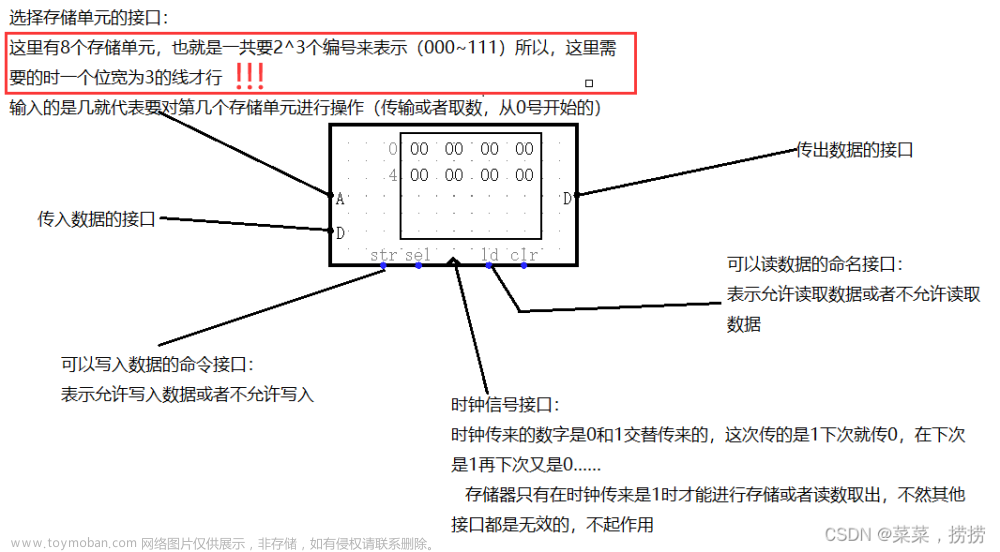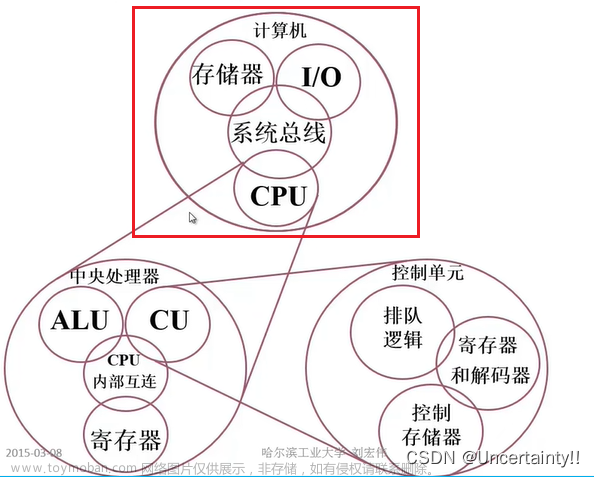一、实验目的
1.掌握存储器的工作原理和接口。
2.掌握存储器的实现方法和初始化方法。
3.掌握RISC-V中存储器的存取方式。
二、实验内容
1.利用vivado IP核创建6432的ROM,并在 系数文件中设置数据为123489ab;
2.利用vivado IP核创建6432的RAM,并在 其上封装一个模块,使得其能完成risc-v 的load/store指令功能。
3.将ROM中的数据读出并保存到RAM中。
4.识别code编码对应的load指令将该数据 从RAM中读出来,结果显示数据的 [31:28][15:12][7:4]。
31:28 15:12 7:4
可选:用七段数码管显示该数据的全部 32位。
三、实验程序
rom
ram
ins
NEWRAM.v
module NEWRAM(
input [5:0] maddr,
input [31:0] mwdata,
input clk,
input we,
input [2:0] mm,
output [31:0] mdata
);
wire [31:0] tmp,tmp_b,tmp_h,tmp_bu,tmp_hu;
wire [31:0] tmp_mwdata;
dataRAM dr(.a(maddr),.d(tmp_mwdata),.clk(clk),.we(we),.spo(tmp));
wire lb,lh,lw,lbu,lhu,sb,sh,sw;
// 识别出各类读写方法
assign lb=~(|mm); // 000
assign lh=~(|mm[2:1])&mm[0]; // 001
assign lw=mm[2]&~(|mm[1:0]); // 100
assign lbu=~mm[2]&mm[1]&~mm[0]; // 010
assign lhu=~mm[2]&(&mm[1:0]); // 011
assign sb=mm[2]&~mm[1]&mm[0]; // 101
assign sh=(&mm[2:1])&~mm[0]; // 110
assign sw=&mm; // 111
// 读数据
assign tmp_b={{24{tmp[7]}},tmp[7:0]};
assign tmp_h={{16{tmp[15]}},tmp[15:0]};
assign tmp_bu={24'b0,tmp[7:0]};
assign tmp_hu={16'b0,tmp[15:0]};
assign mdata={32{lb}}&tmp_b|
{32{lh}}&tmp_h|
{32{lw}}&tmp|
{32{lbu}}&tmp_bu|
{32{lhu}}&tmp_hu;
// 写数据
assign tmp_mwdata={32{sb}}&{24'b0, mwdata[7:0]}|
{32{sh}}&{16'b0, mwdata[15:0]}|
{32{sw}}&mwdata;
endmodule
div.v(分频器)
module div(
input clk,
output clk_new
);
reg[17:0] q = 18'b0;
always @(posedge clk)
begin
q=q+1'b1;
end
assign clk_new=q[17];
endmodule
seven.v(七段数码管)
module seven(
input [3:0] data,
output reg[6:0] out
);
always @(*)
case (data)
4'b0000:out = 7'b1111110; // 7e
4'b0001:out = 7'b0110000; // 30
4'b0010:out = 7'b1101101; // 6d
4'b0011:out = 7'b1111001; // 79
4'b0100:out = 7'b0110011; // 33
4'b0101:out = 7'b1011011; // 5b
4'b0110:out = 7'b1011111; // 5f
4'b0111:out = 7'b1110000; // 70
4'b1000:out = 7'b1111111; // 7f
4'b1001:out = 7'b1111011; // 7b
4'b1010:out = 7'b1110111; // 77
4'b1011:out = 7'b0011111; // 1f
4'b1100:out = 7'b1001110; // 4e
4'b1101:out = 7'b0111101; // 3d
4'b1110:out = 7'b1001111; // 4f
4'b1111:out = 7'b1000111; // 47
default:out = 7'b1111110; //7e
endcase
endmodule
show.v(七段数码管显示)
module show(
input rst,
input clk,
input [31:0] result,
output reg[3:0] an1,
output reg[3:0] an2,
output [6:0] out1,
output [6:0] out2
);
wire clk_new;
div mydiv(.clk(clk),.clk_new(clk_new));
reg [3:0] data1,data2;
reg [1:0] cur_state,nex_state;
// 状态转移
always @(posedge clk_new)
// always @(posedge clk)
begin
if(!rst)
cur_state<=2'b00;
else
cur_state<=nex_state;
end
// 状态转移条件
always @(*)
begin
case(cur_state)
2'b00:
nex_state<=2'b01;
2'b01:
nex_state<=2'b10;
2'b10:
nex_state<=2'b11;
2'b11:
nex_state<=2'b00;
endcase
end
// 状态输出
always @(posedge clk_new)
// always @(posedge clk)
begin
case(cur_state)
2'b00:
begin
an1<=4'b0001;
data1<=result[19:16];
an2<=4'b0001;
data2<=result[3:0];
end
2'b01:
begin
an1<=4'b0010;
data1<=result[23:20];
an2<=4'b0010;
data2<=result[7:4];
end
2'b10:
begin
an1<=4'b0100;
data1<=result[27:24];
an2<=4'b0100;
data2<=result[11:8];
end
2'b11:
begin
an1<=4'b1000;
data1<=result[31:28];
an2<=4'b1000;
data2<=result[15:12];
end
endcase
end
seven myseven1(.data(data1),.out(out1));
seven myseven2(.data(data2),.out(out2));
endmodule
top.v(不用数码管显示)
module top(
input clk,
input rst,
input [2:0] code,
output [31:0] result
);
wire [31:0] addr=32'b0;
wire [31:0] outdata;
wire [31:0] result;
reg we;
reg [31:0] count;
always @(posedge clk)
begin
if (rst==1'b0)
begin
we<=1'b1;
count<=1'b0;
end
else
if (count>=32'b100)
we<=1'b0;
else
count<=count+1;
end
rom myrom(.a(addr),.spo(outdata));
NEWRAM nr(.maddr(addr),.mwdata(outdata),.clk(clk),.we(we),.mm(code),.mdata(result));
endmodule
top.v(用数码管显示)
module top(
input clk,
input rst,
input [2:0] code,
output [3:0] an1,
output [3:0] an2,
output [6:0] out1,
output [6:0] out2
);
wire [31:0] addr=32'b0;
wire [31:0] outdata;
wire [31:0] result;
reg we;
reg [31:0] count;
always @(posedge clk)
begin
if (rst==1'b0)
begin
we<=1'b1;
count<=1'b0;
end
else
if (count>=32'b100)
we<=1'b0;
else
count<=count+1;
end
rom myrom(.a(addr),.spo(outdata));
NEWRAM nr(.maddr(addr),.mwdata(outdata),.clk(clk),.we(we),.mm(code),.mdata(result));
show myshow(.clk(clk),.rst(rst),.result(result),.an1(an1),.an2(an2),.out1(out1),.out2(out2));
endmodule
四、仿真程序
mysim.v(不用数码管显示)
module mysim(
);
reg clk=1'b0;
reg rst=1'b0;
wire[31:0] result;
always
#10 clk=~clk;
initial
#11 rst=1'b1;
reg[2:0] code=3'b011;
top mytop(.clk(clk),.rst(rst),.code(code),.result(result));
endmodule
mysim.v(用数码管显示)
module mysim(
);
reg clk=1'b0;
reg rst=1'b0;
wire [3:0] an1,an2;
wire [6:0] out1,out2;
always
#10 clk=~clk;
initial
#11 rst=1'b1;
reg[2:0] code=3'b011;
top mytop(.clk(clk),.rst(rst),.code(code),.an1(an1),.an2(an2),.out1(out1),.out2(out2));
endmodule
五、仿真结果
不用数码管显示:
用数码管显示: 文章来源:https://www.toymoban.com/news/detail-443541.html
文章来源:https://www.toymoban.com/news/detail-443541.html
六、实验结果
用数码管显示



 文章来源地址https://www.toymoban.com/news/detail-443541.html
文章来源地址https://www.toymoban.com/news/detail-443541.html
到了这里,关于计算机组成原理实验——三、存储器实验的文章就介绍完了。如果您还想了解更多内容,请在右上角搜索TOY模板网以前的文章或继续浏览下面的相关文章,希望大家以后多多支持TOY模板网!














